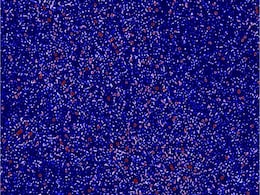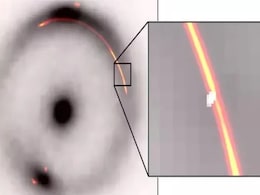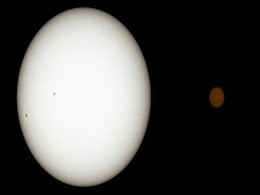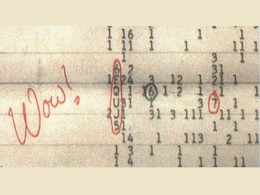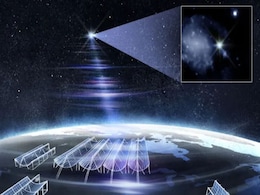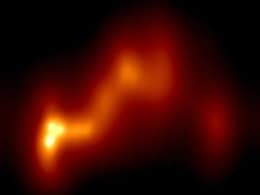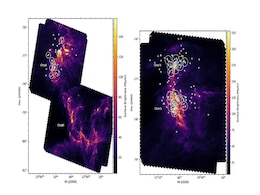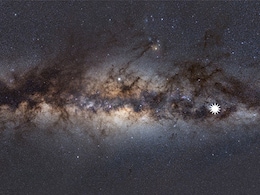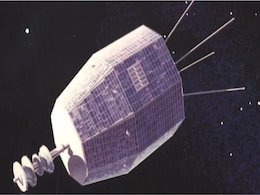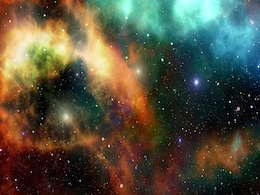Radio Telescope
- All
- News
-

Rare Interstellar Object 3I/ATLAS Fails Alien Test, Scientists Say
- Thursday January 1, 2026
- Written by Gadgets 360 Staff
The most sensitive radio search ever conducted on interstellar object 3I/ATLAS has found no signs of alien technology. Using the Green Bank Telescope, scientists scanned key radio bands during its closest approach to Earth. All detected signals were linked to interference, strengthening the view that 3I/ATLAS is a natural object.
-
 www.gadgets360.com
www.gadgets360.com
-

Astronomers Record First-Ever Massive Stellar Blast Capable Of Stripping Planetary Atmospheres
- Saturday November 22, 2025
- Science | Edited by Astitva Raj
This event originated from a red dwarf star, which is much dimmer, cooler, and smaller than the Sun.
-
 www.ndtv.com
www.ndtv.com
-

How Hot Was the Universe 7 Billion Years Ago? Scientists Now Have an Answer
- Wednesday November 5, 2025
- Written by Gadgets 360 Staff
Japanese astronomers using ALMA data have found the universe was about twice as hot 7 billion years ago, with a temperature of 5.13 K compared to today’s 2.7 K. The finding aligns perfectly with Big Bang predictions that the Universe cools as it expands, providing the most precise mid-epoch measurement yet and reinforcing confidence in standard c...
-
 www.gadgets360.com
www.gadgets360.com
-

Scientists Create Most Detailed Radio Map of Early Universe Using MWA
- Saturday October 18, 2025
- Written by Gadgets 360 Staff
Scientists using the Murchison Widefield Array in Australia analyzed nine years of radio data to study the elusive 21-cm hydrogen signal from the universe’s dark ages. Their findings suggest early black holes and stars had already heated cosmic gas, marking the first observational evidence of this warming phase.
-
 www.gadgets360.com
www.gadgets360.com
-

Astronomers Detect Smallest Known Clump of Pure Dark Matter Using Gravitational Lensing
- Tuesday October 14, 2025
- Written by Gadgets 360 Staff
Astronomers using a global radio telescope array have detected the smallest known pure dark matter clump, roughly a million times the Sun’s mass. Found through a faint gravitational distortion in an Einstein ring, it offers new insight into how dark matter halos form across the universe.
-
 www.gadgets360.com
www.gadgets360.com
-

Chinese Astronomers Search for Extraterrestrial Signals in TRAPPIST-1 System
- Saturday September 20, 2025
- Written by Gadgets 360 Staff
Chinese scientists turned the world’s most sensitive radio telescope, FAST, toward the TRAPPIST-1 system, a promising site for alien life with seven rocky planets. Although no signals were detected, the study set new limits on possible extraterrestrial transmissions and highlighted advanced techniques driving today’s search for intelligent life...
-
 www.gadgets360.com
www.gadgets360.com
-

New Analysis of 1977 Wow! Signal Reveals Stronger Cosmic Mystery
- Wednesday August 27, 2025
- Written by Gadgets 360 Staff
The famous 1977 “Wow!” signal — a mysterious radio burst detected by Ohio’s Big Ear telescope — has been reanalyzed using modern computing techniques. Researchers digitized old telescope records, finding the signal was about four times stronger than first thought, peaking at 250 Janskys. The recalculations also refined its frequency and s...
-
 www.gadgets360.com
www.gadgets360.com
-

Astronomers Detect RBFLOAT, Brightest Fast Radio Burst Ever Observed
- Monday August 25, 2025
- Written by Gadgets 360 Staff
An international team of astronomers has detected RBFLOAT, the brightest fast radio burst (FRB) ever recorded, just 130 million light-years away in Ursa Major. Detected by CHIME in March 2025, the powerful radio flash was traced to galaxy NGC-4141. Follow-up imaging with the James Webb Space Telescope revealed a faint stellar source near the burst,...
-
 www.gadgets360.com
www.gadgets360.com
-

Twisted Jet Confirms Most Extreme Binary Black Hole System in the Universe
- Sunday August 10, 2025
- Written by Gadgets 360 Staff
Astronomers have confirmed that the blazar OJ 287 hosts the most extreme binary black hole system ever found. Using a global radio telescope array, they captured an ultra-sharp image showing a dramatically bent jet—evidence of two supermassive black holes locked in orbit. The system’s 12-year flare cycle and jet twists match predictions of a sm...
-
 www.gadgets360.com
www.gadgets360.com
-

Radio Observations in Chamaeleon Cloud Reveal Five Young Stars, Including a Binary System
- Thursday July 3, 2025
- Written by Gadgets 360 Staff
A team of astronomers using the Australia Telescope Compact Array (ATCA) discovered five young stars in the Chamaeleon cloud complex. One is a probable tight binary system. These findings enhance our understanding of early stellar evolution and the structure of southern star-forming regions.
-
 www.gadgets360.com
www.gadgets360.com
-

Traffic Jam In Space: How Phones, WiFi Are Blocking Signals From Black Holes
- Monday June 30, 2025
- Feature | Lucia McCallum, The Conversation
The scientists who precisely measure the position of Earth are in a bit of trouble. Their measurements are essential for the satellites we use for navigation, communication and Earth observation every day.
-
 www.ndtv.com
www.ndtv.com
-

Most Distant Mini-Halo Discovered in Galaxy Cluster 10 Billion Light-Years Away
- Monday June 30, 2025
- Written by Gadgets 360 Staff
Astronomers have uncovered the most distant mini-halo ever detected, located around the galaxy cluster SpARCS1049, a staggering 10 billion light-years from Earth. Using the LOFAR radio telescope network, which spans eight European countries, researchers detected a faint, diffuse glow—evidence of a giant cloud of high-energy particles and magnetic...
-
 www.gadgets360.com
www.gadgets360.com
-

Dead NASA Satellite Relay 2 May Have Caused Mysterious 2024 Radio Burst
- Friday June 27, 2025
- Written by Gadgets 360 Staff
In June 2024, a mysterious 30-nanosecond radio burst baffled scientists — until they traced it back to a surprising source: Relay 2, a NASA satellite offline since 1967. Researchers believe the signal could have been triggered either by a micrometeorite impact or an electrostatic discharge. The discovery, detailed in a new preprint study, highlig...
-
 www.gadgets360.com
www.gadgets360.com
-

Radio Signal from Early Universe May Reveal the Masses of the First Stars
- Sunday June 22, 2025
- Written by Gadgets 360 Staff
A newly modelled 21-centimetre radio signal from hydrogen atoms just 100 million years after the Big Bang may reveal the mass of the universe’s first stars. Using REACH and the upcoming SKA telescopes, researchers aim to uncover how early starlight shaped cosmic evolution during the Cosmic Dawn, when the universe transitioned from darkness to lig...
-
 www.gadgets360.com
www.gadgets360.com
-

Rare Interstellar Object 3I/ATLAS Fails Alien Test, Scientists Say
- Thursday January 1, 2026
- Written by Gadgets 360 Staff
The most sensitive radio search ever conducted on interstellar object 3I/ATLAS has found no signs of alien technology. Using the Green Bank Telescope, scientists scanned key radio bands during its closest approach to Earth. All detected signals were linked to interference, strengthening the view that 3I/ATLAS is a natural object.
-
 www.gadgets360.com
www.gadgets360.com
-

Astronomers Record First-Ever Massive Stellar Blast Capable Of Stripping Planetary Atmospheres
- Saturday November 22, 2025
- Science | Edited by Astitva Raj
This event originated from a red dwarf star, which is much dimmer, cooler, and smaller than the Sun.
-
 www.ndtv.com
www.ndtv.com
-

How Hot Was the Universe 7 Billion Years Ago? Scientists Now Have an Answer
- Wednesday November 5, 2025
- Written by Gadgets 360 Staff
Japanese astronomers using ALMA data have found the universe was about twice as hot 7 billion years ago, with a temperature of 5.13 K compared to today’s 2.7 K. The finding aligns perfectly with Big Bang predictions that the Universe cools as it expands, providing the most precise mid-epoch measurement yet and reinforcing confidence in standard c...
-
 www.gadgets360.com
www.gadgets360.com
-

Scientists Create Most Detailed Radio Map of Early Universe Using MWA
- Saturday October 18, 2025
- Written by Gadgets 360 Staff
Scientists using the Murchison Widefield Array in Australia analyzed nine years of radio data to study the elusive 21-cm hydrogen signal from the universe’s dark ages. Their findings suggest early black holes and stars had already heated cosmic gas, marking the first observational evidence of this warming phase.
-
 www.gadgets360.com
www.gadgets360.com
-

Astronomers Detect Smallest Known Clump of Pure Dark Matter Using Gravitational Lensing
- Tuesday October 14, 2025
- Written by Gadgets 360 Staff
Astronomers using a global radio telescope array have detected the smallest known pure dark matter clump, roughly a million times the Sun’s mass. Found through a faint gravitational distortion in an Einstein ring, it offers new insight into how dark matter halos form across the universe.
-
 www.gadgets360.com
www.gadgets360.com
-

Chinese Astronomers Search for Extraterrestrial Signals in TRAPPIST-1 System
- Saturday September 20, 2025
- Written by Gadgets 360 Staff
Chinese scientists turned the world’s most sensitive radio telescope, FAST, toward the TRAPPIST-1 system, a promising site for alien life with seven rocky planets. Although no signals were detected, the study set new limits on possible extraterrestrial transmissions and highlighted advanced techniques driving today’s search for intelligent life...
-
 www.gadgets360.com
www.gadgets360.com
-

New Analysis of 1977 Wow! Signal Reveals Stronger Cosmic Mystery
- Wednesday August 27, 2025
- Written by Gadgets 360 Staff
The famous 1977 “Wow!” signal — a mysterious radio burst detected by Ohio’s Big Ear telescope — has been reanalyzed using modern computing techniques. Researchers digitized old telescope records, finding the signal was about four times stronger than first thought, peaking at 250 Janskys. The recalculations also refined its frequency and s...
-
 www.gadgets360.com
www.gadgets360.com
-

Astronomers Detect RBFLOAT, Brightest Fast Radio Burst Ever Observed
- Monday August 25, 2025
- Written by Gadgets 360 Staff
An international team of astronomers has detected RBFLOAT, the brightest fast radio burst (FRB) ever recorded, just 130 million light-years away in Ursa Major. Detected by CHIME in March 2025, the powerful radio flash was traced to galaxy NGC-4141. Follow-up imaging with the James Webb Space Telescope revealed a faint stellar source near the burst,...
-
 www.gadgets360.com
www.gadgets360.com
-

Twisted Jet Confirms Most Extreme Binary Black Hole System in the Universe
- Sunday August 10, 2025
- Written by Gadgets 360 Staff
Astronomers have confirmed that the blazar OJ 287 hosts the most extreme binary black hole system ever found. Using a global radio telescope array, they captured an ultra-sharp image showing a dramatically bent jet—evidence of two supermassive black holes locked in orbit. The system’s 12-year flare cycle and jet twists match predictions of a sm...
-
 www.gadgets360.com
www.gadgets360.com
-

Radio Observations in Chamaeleon Cloud Reveal Five Young Stars, Including a Binary System
- Thursday July 3, 2025
- Written by Gadgets 360 Staff
A team of astronomers using the Australia Telescope Compact Array (ATCA) discovered five young stars in the Chamaeleon cloud complex. One is a probable tight binary system. These findings enhance our understanding of early stellar evolution and the structure of southern star-forming regions.
-
 www.gadgets360.com
www.gadgets360.com
-

Traffic Jam In Space: How Phones, WiFi Are Blocking Signals From Black Holes
- Monday June 30, 2025
- Feature | Lucia McCallum, The Conversation
The scientists who precisely measure the position of Earth are in a bit of trouble. Their measurements are essential for the satellites we use for navigation, communication and Earth observation every day.
-
 www.ndtv.com
www.ndtv.com
-

Most Distant Mini-Halo Discovered in Galaxy Cluster 10 Billion Light-Years Away
- Monday June 30, 2025
- Written by Gadgets 360 Staff
Astronomers have uncovered the most distant mini-halo ever detected, located around the galaxy cluster SpARCS1049, a staggering 10 billion light-years from Earth. Using the LOFAR radio telescope network, which spans eight European countries, researchers detected a faint, diffuse glow—evidence of a giant cloud of high-energy particles and magnetic...
-
 www.gadgets360.com
www.gadgets360.com
-

Dead NASA Satellite Relay 2 May Have Caused Mysterious 2024 Radio Burst
- Friday June 27, 2025
- Written by Gadgets 360 Staff
In June 2024, a mysterious 30-nanosecond radio burst baffled scientists — until they traced it back to a surprising source: Relay 2, a NASA satellite offline since 1967. Researchers believe the signal could have been triggered either by a micrometeorite impact or an electrostatic discharge. The discovery, detailed in a new preprint study, highlig...
-
 www.gadgets360.com
www.gadgets360.com
-

Radio Signal from Early Universe May Reveal the Masses of the First Stars
- Sunday June 22, 2025
- Written by Gadgets 360 Staff
A newly modelled 21-centimetre radio signal from hydrogen atoms just 100 million years after the Big Bang may reveal the mass of the universe’s first stars. Using REACH and the upcoming SKA telescopes, researchers aim to uncover how early starlight shaped cosmic evolution during the Cosmic Dawn, when the universe transitioned from darkness to lig...
-
 www.gadgets360.com
www.gadgets360.com





